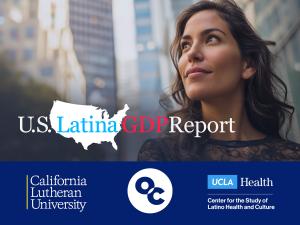
This guest article appeared in the VC Star on April 16, 2025.
For five years now, researchers from California Lutheran University in Thousand Oaks and UCLA have charted the economic success of Latinos in the United States, with their annual Latino GDP report.
Now they've uncovered what they describe as an even bigger success story: that of Latinas, who outpace both their Latino male and non-Latino peers in a number of economic measures.
Oxnard College hosted an event April 15 on the first Latina GDP report, with remarks by two of the authors: Matthew Fienup, the executive director of CLU's Center for Economic Research and Forecasting; and David Hayes-Bautista, the director of the Center for Latino Health and Culture at the UCLA David Geffen School of Medicine.

Their team is also behind the Latino GDP report, which looks at the economic contributions of all Hispanic residents of the United States, male and female. Both studies have found a number of what Fienup called "economic premiums" — areas where Latinos perform better than the rest of the country, such as labor force participation and growth in total economic output.
"No matter how impressive those premiums seem, when we apply this methodology and calculate the U.S. Latina GDP, we find premiums that are even larger," Fienup said.
For example, the gross domestic product, or GDP, produced by Latinas in the United States was $1.3 trillion in 2021, the most recent year for which complete statistics are available. GDP refers to the value of all goods and services produced in an economy, and the figure for U.S. Latinas means that if they were a state of their own, its economy would be slightly bigger than Florida's and smaller than only California, Texas and New York.
Even more impressive is the growth in Latinas' economic productivity. From 2010 to 2021, the Latina GDP grew at an average of 3.8% per year, faster than that of Latino men and of the U.S. as a whole, which grew at a rate of 1.8% per year in that period.